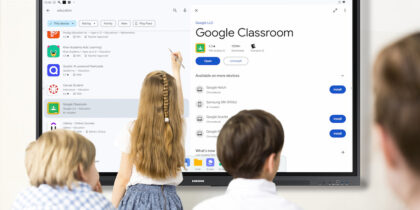A recent survey showed that teachers are supportive of innovative teaching and learning strategies, but they aren’t using tech tools for teachers and students in very creative ways. Twenty-two percent of them reported asking students to use technology for daily drills, review or practice exercises — nearly four times as many as those who used it on a daily basis for group projects.
There are a few reasons for teachers’ tendency to use technology for these more routine tasks. First, the teachers surveyed said that a lack of devices (42 percent) and reliable internet access (28 percent) are still ongoing issues. Lack of guidance from above (20 percent) and the demands of state and district curriculum (30 percent) also play into this reliance on drill and practice technologies. The biggest issue, though, is a lack of training (33 percent).
Effective Training Models the Ideal Classroom
One of the best ways to help increase innovation and see the real benefits of technology in the classroom is to give teachers training that integrates collaborative activities, heterogeneous groupings, analysis and synthesis of ideas, and access to technology to look up facts rather than memorize them. When teachers get used to learning in this way, they can envision these higher level activities in their own classrooms.
Another key element of strong professional development is to incorporate group activities. Allowing teachers to work together in cross-curricular groups to create lesson plans that tie their classes together puts professional development into context and gives them innovative tools they can use in their classrooms right away.
Lastly, training should be ongoing. Incorporate discussion and collaboration into staff meetings so training isn’t a one-off deal on in-service days. This will also help keep new classroom activities tied into the district curriculum and help teachers see that they’ve got buy-in from above.
Involve Students
Student-driven activities increase student engagement and retention, and helps prepare them for the demands of higher education and work. Theses activities can be hard to fit into an already packed curriculum, though, so make sure you’re fostering an environment that balances student excitement and district requirements.
One way to start the school year off in a student-driven way is to let students pick the classroom arrangement. Let them group desks in ways that allow them to balance collaboration and focus. They can choose technology centers, quiet areas and other arrangements based on their needs and the course outline shared by the teacher on the first day of class. This sets an expectation from day one that students are active participants in the design and success of their learning.
Collaboration Can Be a Central Focus
One of the great benefits of technology in the classroom is the collaboration it enables. There are many free and low-cost tech tools for teachers that foster collaboration. Google Docs allows students to collaborate on group projects in and out of the classroom. Email and chat tools can connect them with experts and peers in any location. Online research tools — both free and paid — open up access to information for class projects and further study. And using these tech tools doesn’t have to be an addition to the regular curriculum. Collaboration can be integrated into the typical course of study with just a little planning.
As the new school year begins, teachers can create new ways to use the technology available to them in more innovative ways. In schools with limited access, it may require more juggling and some creative ways to improve sharing of resources, but it can be done. As the survey shows, a majority of teachers are ready and willing to make the necessary effort.
Gamification can play a key role in creating a more engaged digital classroom. Learn about the science behind gamification in education here.








